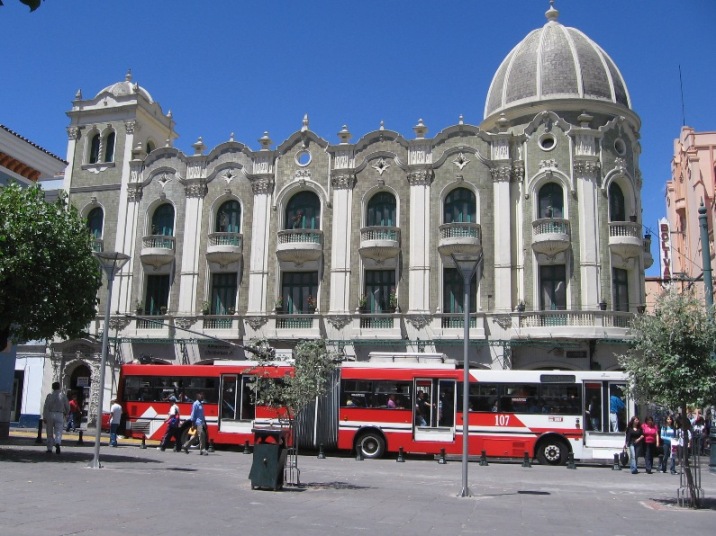Ecuador is not immune from the Latin American trend of urban development, where it is estimated that 80% of the population lives in urban areas [es]. In the country, most of its people reside in the city of Guayaquil and in the capital city of Quito. With that population concentration, comes the usual array of urban problems, including traffic congestion, which often keeps parts of Quito at a standstill.
That is why October 24, 1995 became a historical date for Quito because the first 14 trolley bus prototypes arrived and were enthusiastically received by the people. That is how the Trolley Quito Co. [es] (CTQSA for its initials in Spanish) started to alleviate the north-south traffic congestion. By 1996, the system had been moving an average of 50 to 90 thousand people per day, and now, the 113 trolley buses in operation are helping to cut down on pollution, noise and at the same time, speed up traffic through downtown.

Trolley service through Guayaquil St in Quito, nearby the Plaza Grande. Photo credit to Wikimedia Commons
Quito's trolley buses have become an integral part of the city's urban landscape and prompted one journalist, Susana Morán, to launch a reporting project called “So We Travel on the Trolley Bus.” This project invited Ecuadorian twitterers to publish their experiences using the trolley bus in Quito, and to use the hashtag #troleq in order to collect the information.
She also conducted several online chats with Ecuadorians to collect anecdotes and opinions of the transport system. The transcripts can be found on her blog [es], and one participant, 24 year-old Pablo Vayas described one of his experiences:
Hay muy pocas unidades en horas pico. Una anécdota: un día no tuve dinero y traté de usar mi tarjeta del trole. Ésta no funcionó pues la banda magnética se había dañado. Empezó a llover y tenía que tomar el trole si o sí. Un señor me vio y sin hablar me dio 25 centavos y le dije que “gracias, me salvó.”
There are very few buses during peak hours. An anecdote: One day I had no money and tried to use my trolley bus card. It did not work because the magnetic strip was damaged. It started to rain and I had no choice, but to take the trolley bus. A man saw me and without word gave me 25 cents. I told him “thanks, you saved me.”
There were several active and enthusiastic twitterers, who participated. The tweets ranged from complaints about the system, but also recommendations on how to improve the overall experience. Diego Cevallos [es], also known as @diegocevallosn, complained about the trolley bus schedule because certain routes only operate until 8 or 9 pm [es]. He also had a bad experience as a victim of a robbery:
Recuerdo hac 1año al bajar del trole descubri mi maleta abierta y sin ipod q “profesionales” pensé -notese la ironía- no sentí nada #troleq
The problem with security on the trolley bus is reoccurring theme and the overall mood of the ride. Estéfano Dávila or @ferrimankenobi on Twitter wrote:
Pero todos siempre nos hacemos los locos, no saludamos nunca. Hay bastante desconfianza por la delincuencia
However, it is also concern about safety because the actions of the driver, as Dávila writes:
uuuu, me toco un chofer q va en carrera consigo mismo. Acelera full, y trata de rebasar como sea y por donde sea #troleq
Even when CTQSA launched a campaign Somos un Transporte, Amable, Solidario e Incluyente (We are a friendly service of transportation, supportive and inclusive), Alex Llumiquinga [es] who goes by @patrikalex thinks that there are still issues with the onboard experience.
#troleq abran una ventanita por dios… parada sto domingo
#troleq el sr d seguridad ha desarrollado una capacidad increible para meter gente
the Security guys have developed an incredible ability to make room for more people
Diego Granda [es] @diegogranda. almost never rides the trolley, but for the activity, he wanted to join his fellow tweeters. Moreover, he still believes that if tweets were made with image and video, then the project would have been better, something that Paul Barahona [es] (@palulo) did by posting videos on his Qik account [es].
Finally, Christian Espinosa of Cobertura Digital [es] provides an overview of the project and sees the potential for future journalistic activities. He writes that in the past, journalists did not even dream of live coverage and now projects like this are enabling the addition of new sources to the news.






